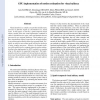Free Online Productivity Tools
i2Speak
i2Symbol
i2OCR
iTex2Img
iWeb2Print
iWeb2Shot
i2Type
iPdf2Split
iPdf2Merge
i2Bopomofo
i2Arabic
i2Style
i2Image
i2PDF
iLatex2Rtf
Sci2ools
DASIP
2010
2010
GPU implementation of motion estimation for visual saliency
Visual attention is a complex concept that includes many processes to find the region of concentration in a visual scene. In this paper, we discuss a spatio-temporal visual saliency model where the visual information contained in videos is divided into two types: static and dynamic that are processed by two separate pathways. These pathways produce intermediate saliency maps that are merged together to get salient regions distinct from what surround them. Evidently, to realize a more robust model will involve inclusion of more complex processes. Likewise, the dynamic pathway of the model involves compute-intensive motion estimation,that when implemented on GPU resulted in a speedup of up to 40x against its sequential counterpart. The implementation involves a number of code and memory optimizations to get the performance gains, resultantly materializing real-time video analysis capability for the visual saliency model.
DASIP 2010 | Image Processing | Real-time Video Analysis | Spatio-temporal Visual Saliency | Visual Saliency Model |
| Added | 14 May 2011 |
| Updated | 14 May 2011 |
| Type | Journal |
| Year | 2010 |
| Where | DASIP |
| Authors | Anis Rahman, Dominique Houzet, Denis Pellerin, Lionel Agud |
Comments (0)

